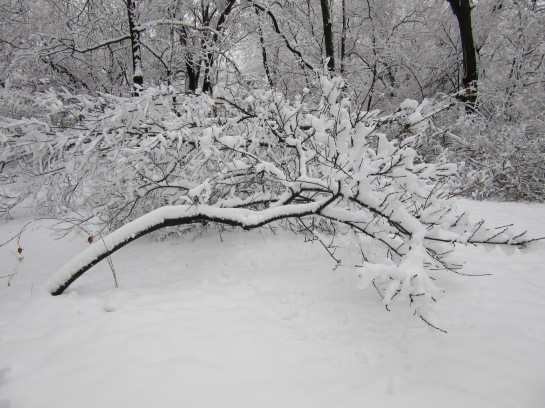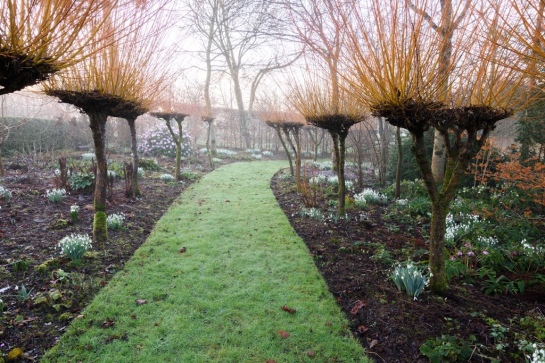
Ice storm last month brought this 30-footer down, just missing the peach tree at left, out of frame. It has to sit for a while–the ground a quagmire. A chainsaw fiesta at the end of the month.


I ordered ‘Conca d’Or’ lily bulbs, arriving in April, to plant along the North fence line, where there is too much sun for Hydrangea quercifolia. My good neighbor is an avid gardener and the friendly lilies will lean to his sunnier garden, an easy color, perfuming the place. Photo Uleli, Wikimedia Commons.

Rachel Carson.
Your question cannot be answered because it depends on incorrect assumptions. Nothing. Un-ask the Question. – (approximately) the concept of Mu.
Climate rewind: Scientists turn carbon dioxide back into coal
Scientists have harnessed liquid metals to turn carbon dioxide back into solid coal, in research that offers an alternative pathway for safely and permanently removing the greenhouse gas from our atmosphere. The new technique can convert carbon dioxide back into carbon at room temperature, a process that’s efficient and scalable.
Science Daily
What is Fynbos?
This region is considered to be one of the world’s six floral kingdoms and is the only one that occurs within a single country. The area encompassed by the Fynbos Biome is known as the Cape Floristic Region (CFR). The Cape Floristic Region is recognised by UNESCO as a World Heritage Site for its rich and diverse flora as well as levels of endemism.
Notes from a Cape Town Botanist
Corsican Plantes des Maquis
A French island off the coast of Italy just north of Sardinia, Corsica is an undeveloped environmental paradise whose highest elevations are dominated by craggy granite mountains skirted by forests of pine, green oak, or chestnut. Lower on the slopes, the middle maquis presents vast acres of heathers (Erica spp.), myrtles (Myrtus spp.) and strawberry trees (Arbutus unedo) growing so closely together that the hillsides are almost impenetrable, save for barely discernible shepherds’ paths.
Pacific Horticulture
Stone Setting in the Japanese Garden
Stones are accorded an almost reverential quality in the garden, and a great deal of care is taken in the selection and placement of stones. They are regarded as forming the essential skeleton of the garden, providing the garden layout with a fixed and subtle framework that will define the overall structure of the garden.
Robert Ketchell
Wildflowers of the Tallgrass Prairie
This collection profiles wildflowers of the tallgrass prairie. Stretching over 250 million acres, the tallgrass prairie was once the largest ecosystem in the United States. Its deep rich soils made excellent farmland. By 1860, most of the tallgrass prairies had fallen to the plow. Today, only about one million acres remain, making tallgrass prairie one of the most threatened natural communities.
Lady Bird Johnson Wildflower Center
Study yields new clues to predict tipping points for marsh survival
Coastal salt marshes provide a long list of ecosystem services that benefit humans, including shoreline protection, pollution filtration, flood prevention, fishery habitat and carbon sequestration.
Phys Org
Plants and Frozen Ground
Plants can grow in extreme conditions, including frozen ground. Plants need sunlight, nutrients from the soil, and water to live. In some places in the Arctic, the ground is frozen most of the year, and months go by without any sunlight. How do plants survive?
National Snow & Ice Data Center
20 Edible Plants and Funghi You’ll Find on the Appalachian Trail
Warning: Make sure, particularly with berries and mushrooms, that you are 100% positive on the identification of the species before you consume them! This guide is meant to spark your interest in studying edible and medicinal plants and should not be used as any sort of scientific identifier or medical advice.
The Trek
How a Rose Blooms: Its Genome Reveals the Traits for Scent and Color
Although the rose genome has been mapped before, a newly published version is far more complete, indicating which genes tend to travel together — scent and color, for instance — and which genes are responsible for continuous blooming, among other traits.
New York Times
Top 10 Primulas for the Garden
Growing different types allows you to stretch the primrose season well into early summer too. From meadows to bog gardens and streamsides, to brilliantly colourful houseplants for indoor windowsills, the primrose family provides solutions for many places.
The English Garden
Galtonia
A friend recently asked me how to tell apart the different species of Galtonia, a South African genus of four species in the Hyacinthaceae, closely related to and sometimes included in Ornithogalum. …The most familiar by far is Galtonia candicans, with abundant, large, pure white flowers: a magnificent hardy bulb for the summer garden.
John Grimshaw’s Garden Diary
The best new vegetables of 2019
For your planning pleasure, we’ll take a look over the next four weeks at what growers, local garden centers, and other plant experts say are some of the best new plants poised to hit the market.
Penn Live
The Wisdom of Wes Jackson, Founder of The Land Institute
In 1976, Jackson founded The Land Institute in Salina, Kansas to research ways to reverse the degradation of our agricultural landscapes. For 40 years, he has worked to breed a commercially viable perennial grain, a key component of his vision for a more holistic agriculture in which annual monocultures are replaced by perennial polycultures – mixtures of complementary crops that have the innate resilience and high biological productivity of natural ecosystems.
Modern Farmer
The Life and Legacy of Rachel Carson
One way to open your eyes is to ask yourself, What if I had never seen this before? What if I knew I would never see it again?
Rachel Carson
I wondered why the frisbee was getting bigger, and then it hit me. – Anonymous via Firestar.
Status of Spring
How do you know when spring has begun? Is it the appearance of the first tiny leaves on the trees, or the first crocus plants peeping through the snow?
National Phenology Network

Hedgehog House, Leicestershire, UK.
